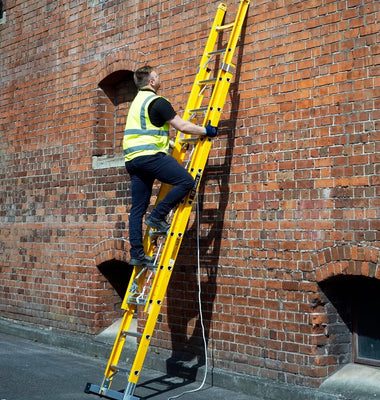
Mastering the Art of Ladder Use: A Comprehensive Guide
November 16, 2023
Ladders are indispensable tools in both professional and household settings, facilitating access to elevated spaces with ease. However, using a ladder improperly can lead to accidents and injuries. To ensure safety and efficiency, it is crucial to understand the fundamentals of ladder use. This comprehensive guide will explore the key aspects of using a ladder properly, covering everything from selecting the right ladder to safe climbing techniques.
Choosing the Right Ladder:
Before ascending a ladder, it’s essential to select the right type and size for the task at hand, so choosing the right ladder for the right jobs is the most important task. Consider the following factors:
- Type of Ladder:
- Step Ladders: Ideal for tasks that require a stable base, such as painting or reaching overhead shelves.
- Extension Ladders: Suitable for tasks that involve reaching higher places, like cleaning gutters or accessing rooftops.
- Material:
- Aluminum ladders are lightweight and resistant to corrosion, making them suitable for indoor and outdoor use.
- Fiberglass ladders are non-conductive and are the preferred choice when working near electrical sources.
- Weight Capacity:
- Ensure that the ladder’s weight capacity exceeds your own weight and the weight of any tools or materials you will be carrying.
Setting Up the Ladder:
Proper setup is crucial to ensure stability and prevent accidents. Follow these steps:
- Surface Inspection:
- Choose a level surface for ladder placement, free of debris or slippery substances.
- If using an extension ladder, make sure the ground is firm, and use leveling devices if necessary.
- Positioning:
- Place the ladder at a safe angle, following the 1:4 ratio rule. For every 4 feet of ladder height, the base should be positioned 1 foot away from the vertical surface.
- Locking Mechanisms:
- Ensure that all locking mechanisms, such as spreaders on a step ladder or locks on an extension ladder, are engaged securely.
Safe Climbing Techniques:
Once the ladder is set up correctly, use the following techniques to climb safely:
- Face the Ladder:
- Always face the ladder while climbing and descending. Keep your body centered between the side rails and maintain a firm grip.
- Three-Point Contact:
- Maintain three points of contact with the ladder at all times. This means two hands and one foot, or two feet and one hand, should be in contact with the ladder.
- Tool Belt:
- Use a tool belt or a bucket attached to a rope to transport tools, rather than carrying them in your hands while climbing.
- No Overreaching:
- Avoid leaning too far to one side or overreaching, as it can cause the ladder to become unstable. Descend and reposition the ladder if necessary.
- Weight Limit:
- Adhere to the ladder’s weight limit, and never exceed the maximum load capacity. This includes both your body weight and any tools or materials you’re carrying.
Maintenance and Inspection:
Regular maintenance and inspection are essential to ensure the ongoing safety and reliability of your ladder. Follow these guidelines:
- Visual Inspection:
- Regularly inspect the ladder for any visible damage, such as cracks, bent rungs, or loose hardware.
- Functional Check:
- Test the locking mechanisms, hinges, and any moving parts to ensure they are in proper working order.
- Cleaning:
- Clean the ladder regularly to remove dirt, grease, or other substances that may compromise its integrity.
- Storage:
- Store ladders in a dry, cool environment away from direct sunlight, and consider covering them to prevent unnecessary wear.
Mastering the art of ladder use is not only about reaching new heights efficiently but also about ensuring your safety and the safety of those around you. By choosing the right ladder, setting it up correctly, following safe climbing techniques, and maintaining it properly, you can make every ascent a secure and successful one. Remember, a well-used ladder is a tool that opens doors, both literally and figuratively, so use it wisely and with the utmost care.




